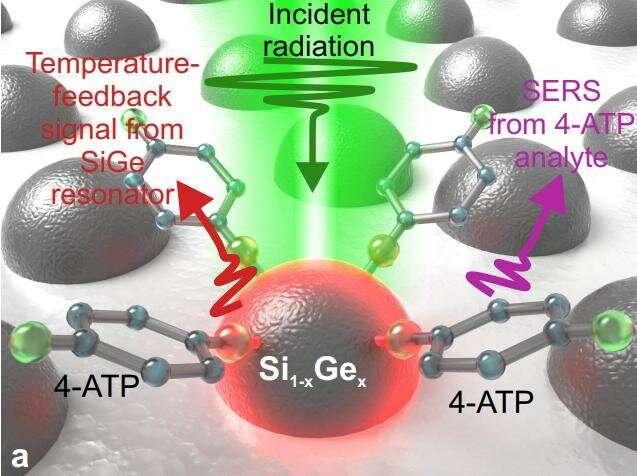AD alloyed nanoantennas for temperature-feedback identification of viruses and explosives

Scientists of Far Eastern Federal University (FEFU) in collaboration with colleagues from Far Eastern Branch of Russian Academy of Sciences (FEB RAS), ITMO University and Swinburne University of Technology (Australia), have developed a method for efficient mass production of silicon-germanium fully alloyed nanoantennas. The technology has potential applications in optical biosensory platforms and next-generation chemical sensors for fast and accurate tracing of viruses, pollutions, explosives, etc. at low concentrations. The study is published in Nanoscale.
To fabricate all-dielectric (AD) optical nanoantennas, scientists have proposed a facile technology based on a temperature-assisted dewetting of commercial silicon-on-insulator (SOI) substrates at 800 degrees C in high vacuum. Such treatment of an SOI substrate leads to the formation of silicon nanodrops, which can be used as optical nanoantennas, amplifying the signals from various adsorbed molecules. The deposition of Ge in the process of SOI dewetting produces alloyed nanoparticles with unique properties. Such nanoantennas allow scientists to identify adsorbed molecules as well as to access and control the local temperature at high accuracy and resolution in the process of measurement.
"It's very useful to know the local temperature, because in the process of measurement, both the nanoantennas and the adsorbed analyte molecules are exposed with intense laser radiation which causes their heating. At the same time, most organic molecules degrade at rather low temperatures around 130-170 degrees C, i.e. in the process of measurement, one can simply burn them up before getting a useful signal. Such useful temperature-feedback modality cannot be realized with plasmonic nanoantennas commonly used to design biosensors. All-dielectric nanoantennas provide a reliable way to achieve this feature, as the measured characteristics spectrum of the analyte molecules already contains all information required to determine the local temperature of the nanoantenna-molecule system," said Aleksandr Kuchmizhak, a researcher in the FEFU Center for Virtual and Augmented reality.
"By controlling the concentration of germanium in the alloyed silicon nanoparticles, one can tailor their properties; in particular, control their resonant optical characteristics, as well as the light-to-heat conversion efficiency. This is very useful for studying of various chemical processes and reactions induced by laser radiation," said Evgeny Mitsai, a researcher at Institute of Automation and Control Processes and Institute of Chemistry, FEB RAS.
The scientist emphasized that by using all-dielectric nanoantennas, scientists can study in detail the temperature-mediated effects in laser-induced chemical reactions at high temporal resolution. Moreover, all-dielectric nanoantennas remain chemically noninvasive.
Until today, the mass production of all-dielectric nanoantennas was difficult. Commonly used electron-beam lithography was too expensive and time-consuming. The technology proposed by FEFU scientists in collaboration with their colleagues from the FEB RAS, ITMO University, universities of Australia and Tunisia, allows getting over this limitation.
More information: Eugeny Mitsai et al, Si1−xGex nanoantennas with tailored Raman response and light-to-heat conversion for advanced sensing applications., Nanoscale (2019). DOI: 10.1039/C9NR01837A
Journal information: Nanoscale
Provided by Far Eastern Federal University




















